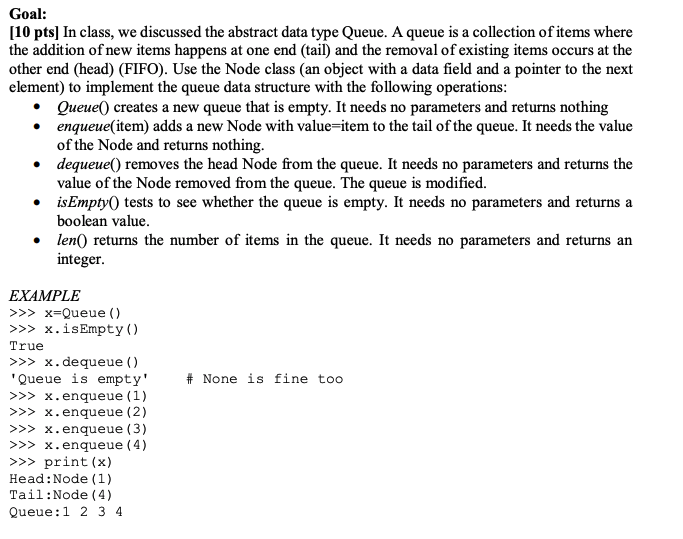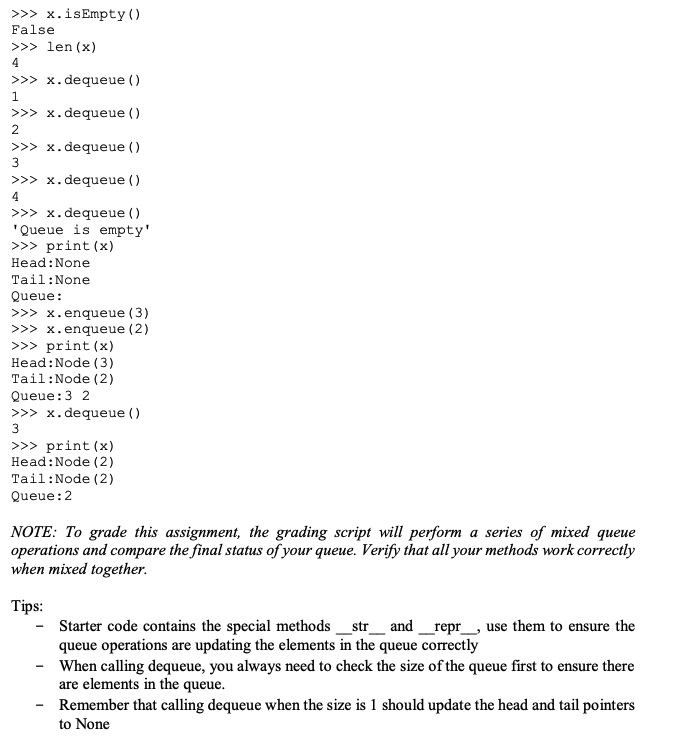Question
Write Code in Python class Node: def __init__(self, value): self.value = value self.next = None def __str__(self): return Node({}).format(self.value) __repr__ = __str__ class Queue: '''
Write Code in Python


class Node:
def __init__(self, value):
self.value = value
self.next = None
def __str__(self):
return "Node({})".format(self.value)
__repr__ = __str__
class Queue:
'''
>>> x=Queue()
>>> x.isEmpty()
True
>>> x.dequeue()
'Queue is empty'
>>> x.enqueue(1)
>>> x.enqueue(2)
>>> x.enqueue(3)
>>> x.dequeue()
1
>>> print(x)
Head:Node(2)
Tail:Node(3)
Queue:2 3
'''
def __init__(self):
self.head=None
self.tail=None
def __str__(self):
temp=self.head
out=[]
while temp:
out.append(str(temp.value))
temp=temp.next
out=' '.join(out)
return
('Head:{} Tail:{} Queue:{}'.format(self.head,self.tail,out))
__repr__=__str__
def isEmpty(self):
#write your code here
def __len__(self):
#write your code here
def enqueue(self, value):
#write your code here
def dequeue(self):
#write your code here
Goal: [10 pts] In class, we discussed the abstract data type Queue. A queue is a collection of items where the addition ofnew items happens at one end (tail) and the removal of existing items occurs at the other end (head) (FIFO). Use the Node class (an object with a data field and a pointer to the next element) to implement the queue data structure with the following operations Queue) creates a new queue that is empty. It needs no parameters and returns nothing .enqueue(item) adds a new Node with value-item to the tail of the queue. It needs the value of the Node and returns nothing. dequeue) removes the head Node from the queue. It needs no parameters and returns the value of the Node removed from the queue. The queue is modified. . isEmpty0 tests to see whether the queue is empty. It needs no parameters and returns a boolean value * len) returns the number of items in the queue. It needs no parameters and returns an integer e len EXAMPLE >>x-Queue () >>>x.isEmpty() True >>> x.dequeue () Queue is empty >>> x.enqueue (1) >>> x.enqueue (2) >>> x.enqueue (3) >>> x.enqueue (4) >>>print (x) Head: Node (1) Tail:Node (4) Queue1 2 3 4 # None is fine tooStep by Step Solution
There are 3 Steps involved in it
Step: 1

Get Instant Access to Expert-Tailored Solutions
See step-by-step solutions with expert insights and AI powered tools for academic success
Step: 2

Step: 3

Ace Your Homework with AI
Get the answers you need in no time with our AI-driven, step-by-step assistance
Get Started


